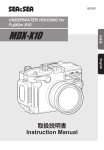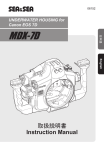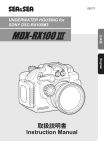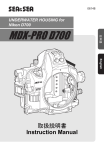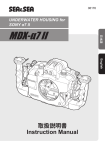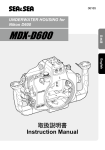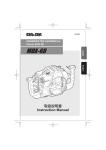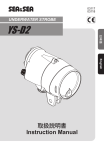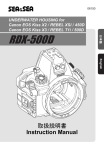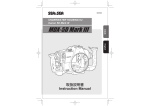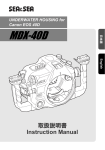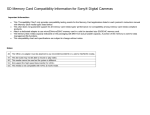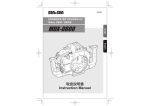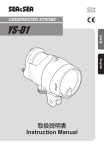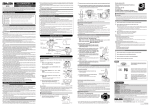Download Sea&Sea MDX-RX100/? Instruction manual
Transcript
06170 UNDERWATER HOUSING for SONY DSC-RX100/DSC-RX100M2 日本語 MDX-RX100/Ⅱ English 取扱説明書 Instruction Manual Introduction Thank you for purchasing SEA&SEA products. Please read this instruction manual carefully prior to using this product. Only with a thorough understanding of this manual’s content will you be able to use the housing correctly. After reading the manual, please be sure to keep it in a place where you can easily come back to it at any time. Note: Pressure-resistance inspection sticker Products bearing this sticker are those that have passed SEA&SEA’s criteria-based inspection for pressure resistance. The appearance of color evenness or weld lines on the external body of the product is normal and will not affect its performance. Contents Safety Precautions ......................................................................... E-2 Precautions on Handling the O-ring ............................................... E-4 Identification of Parts ..................................................................... E-6 Preparation for Setting Up ............................................................. E-7 Prepare the housing ................................................................. E-7 Prepare the digital camera ....................................................... E-8 Prepare the connecting accessories ........................................ E-8 Opening and Closing the Housing ................................................. E-9 Mounting the Camera in the Housing .......................................... E-11 Connecting the Strobe ................................................................. E-13 External Controls .......................................................................... E-14 Attaching the Hand Strap ............................................................. E-15 Attaching the Optional Accessories .............................................. E-16 Maintenance and Storage .............................................................E-19 Specifications ................................................................................ E-20 E-1 Safety Precautions For safe handling of the product, please read the following precautions carefully before use. Failure to heed the precautions listed below could result in serious consequences. To prevent injury or damage to yourself and/or others, please observe the precautions as they contain highly important information related to personal and product safety. WARNING Situations that could result in severe injury or death. CAUTION Situations that could result in property damage or personal injury. WARNING Keep out of reach of children to prevent accidental ingestion. If swallowed, seek medical advice immediately. CAUTION Carefully observe the instruction manual for the compatible camera for this product before use. This product has been designed and manufactured for use at a water depth within 100m / 330ft. Please note that diving to a depth in excess of 100m / 330ft may cause damage to the product or may lead to water leakage. Unauthorized disassembling and/or modification could result in malfunction or flooding, and void product warranty. Take the product to a SEA&SEA authorized service center for repair or inspection. Should you notice smoke or an unusual smell coming from the product, turn it off and remove the batteries immediately, taking care to avoid burns. Continued operation could result in injury. After removing the battery, take the product to a SEA&SEA authorized service center for inspection. Discontinue use and turn the product off immediately should you notice flooding or leakage. When the product is flooding, interior pressure may build up. Please be careful when opening the product as water may spurt out or the cap may open explosively and cause injuries. The product has been constructed with an airtight seal. When packing the product for airplane travel, do not seal-up the product to alleviate pressure build up due to atmospheric changes. Do not open the product in a wet or sandy environment. Protect the interior from moisture and debris in order to prevent malfunction or flooding. Avoid strong shocks/impacts or excess stress to prevent malfunction, damage or breakdown. Make sure that the product has been securely mounted to other products in order to prevent injury, fall or missing. E-2 Safety Precautions Do not rest heavy weight on the product. It might deform the outer casing, damage internal parts, make the waterproofing fail, or result in fire or electric shock. Please note that some marks may be left on the camera scraping against the dials or gears of the housing. Handle the product carefully so as not to scratch the front port, the lens, the flash window or the finder. Always dry the front port, the lens, the flash window or the finder using a soft cloth to prevent stain or salt residue from marring the glass surface. Rinse the product with fresh water, after underwater use. Ensure that the product is waterproofed before rinsing. Refer to [Maintenance and Storage] (P.E-19) for details. Make sure that the connectors have been secured with the connector caps before rinsing the product with fresh water, after removal from other products. Never use chemicals, cosmetics, any petroleum solvents such as paint thinner, or neutral detergent on the product. They may deform and damage the product. Do not leave the product in places with hot temperatures such as inside of a car or in a car trunk in summer. The heat may deform plastic parts of the product, damaging internal parts and resulting in potential fire or electric shock. If the product is sealed tight in hot conditions, heated air expanding inside the product may deform the casing and ruin the waterproofing. Do not store the product in wet or high humidity place, to avoid mold, rust, corrosion or malfunction. Do not store the product with naphthalene or camphor mothballs, or in locations such as a laboratory where chemicals are used. This environment can cause mold, rust, corrosion or malfunction. SEA&SEA SUNPAK Co., Ltd. assumes no liability for compensation of loss of captured images or expenses caused by loss of images, even if you are unable to shoot due to a product defect or malfunction. SEA&SEA SUNPAK Co., Ltd. will not be responsible for the replacement or compensation for cameras, lenses or those accessories damaged due to your invalid operation. SEA&SEA SUNPAK Co., Ltd. assumes no liability for errors or discrepancies in this manual. Carefully observe the O-ring maintenance manual for the handling of O-rings before use. The silicon grease included in the product package is inedible. E-3 Precautions on Handling the O-ring This product is kept watertight by the O-ring. To keep the O-ring functioning properly, please observe the following. Improper handling of the O-ring could cause flooding. CAUTION SEA&SEA products use blue O-rings. These O-rings are impregnated with silicone oil through a special process. The lubricating effect of the O-ring lasts as long as the silicone oil is gradually seeping out from within. For the maintenance of these blue O-rings, make sure to use genuine SEA&SEA silicone grease (O-ring grease for use with the blue O-rings that comes in tubes with blue lettering and blue caps). If you use silicone grease from other companies or SEA&SEA’s own silicone grease that comes in tubes with black lettering and black caps, the grease you apply will be sucked into the blue O-rings due to their special characteristics, which will result in insufficient grease. If this happens even once, the O-ring will not revert to its normal state and must be replaced. If the grease is insufficient, the O-ring will not slide, and it will become harder to open and close the waterproof parts. Because of this, it could become impossible to open or close the housing or it could cause flooding, so please refrain from using the housing with insufficient grease. Are there any scratches or cracks in the O-ring? Check the O-ring to make sure there are no scratches or cracks. If there are, replace the O-ring with a new one immediately. When handling the O-ring, do not use pointed metal objects, which could damage the O-ring. Use of the included O-ring remover is recommended. O-ring remover Be careful about dust, sand, and hair Check the O-ring to make sure that there is no dust, sand, or hair on the O-ring, in the O-ring’s grooves, or on the O-ring’s contact surfaces. If any of these things are attached, remove them completely. If used as is, these things could cause flooding. E-4 Precautions on Handling the O-ring Coat with silicone grease Silicone grease protects the O-ring from chafing. After checking the O-ring to make sure that there are no scratches, dust, or debris, apply a light coating of silicone grease to the entire O-ring with your finger. Applying too much grease will make it easier for dust and debris to adhere to the O-ring, and could cause flooding. Do not twist the O-ring When fitting the O-ring into the O-ring groove, insert it straight into the groove; do not bend or twist it. Remove the O-ring for inspection before each use In principle, the O-ring should be removed before each use so that the O-ring, O-ring groove, and O-ring contact surfaces can be checked. This is because you cannot find any sand or debris that may have gotten into the O-ring groove if the O-ring is not removed. For routine maintenance prior to each use, it is advisable to make sure to remove the O-ring. Be careful about how you store O-rings When storing spare O-rings or O-rings that you have removed from the housing, keep them in a cool place out of direct sunlight. Also, when storing O-rings, do not place heavy objects on them or twist them. O-rings last for one year Although it depends on how well they are maintained, how often they are used, and how they are stored, O-rings generally last for one year. It is advisable to inspect them before use, and replace them early. E-5 Identification of Parts Accessory shoe Fiber-optic cable socket Zoom lever Shutter lever Control dial Lock knob Mount for SA8 fixed flash base Port*1(M67 screw) Front case Power button Mode dial Movie-record button MENU button Monitor window Selection button LCD monitor hood holder Tripod socket (bottom) Control wheel Delete button Playback button Fn button Rear case *1 A wide-angle conversion lens or an M67→M62 Step Down Ring can be screwed onto the front. E-6 Preparation for Setting Up This product must be used in combination with the optional equipment (digital camera, port, strobe, accessories etc.) for underwater photography. In order to set up the equipment, prepare each item correctly. Prepare the housing [With the RX-100M2] • Attach four rear cushion rubbers (small) on the rear window (four positions). Rear cushion rubber (small) [With the RX-100] • Attach four rear cushion rubbers (large) on the rear window (four positions). Rear cushion rubber (large) • Replace the mode dial rubber (small → large). (small) Mode dial rubber Mode pulley Mode dial rubber (large) • Replace the wheel rubber (small → large). ● The mode dial rubber should be fitted firmly in the groove of the mode pulley. Wheel rubber (small) (large) CAUTION ●Push it in firmly as far as it will go. ● Be sure to retain the replaced parts. The port on this product is built into the housing and thus cannot be removed. E-7 Preparation for Setting Up Maintaining the O-ring O-ring This product is kept watertight by the O-ring. To keep the O-ring functioning properly, please observe the following before setting up. Make sure to remove the O-ring when maintaining. For detailed O-ring maintenance methods, please see the O-ring maintenance manual. CAUTION Make sure to fit/install the O-ring into the groove properly after maintenance. Prepare the digital camera This product is exclusively designed for use with Sony DSC-RX100/DSC-RX100M2 digital camera. Other cameras are not compatible with this product. Make sure that there is sufficient battery power remaining and the image storage medium has enough room for the number of pictures. Remove the strap from the camera if any of these accessories are attached. Make sure the camera is operating correctly, referring to the camera's instruction manual for details. Prepare the connecting accessories When using external strobes, lights or other accessories in combination with this product, prepare the equipment before setting up. If the accessories are kept watertight by O-rings, make sure the O-rings are properly maintained. If the accessories are powered by batteries, make sure that there is sufficient battery power remaining. Make sure the equipment is operating correctly, referring to the instruction manual provided with the equipment. E-8 Opening and Closing the Housing Opening and closing the housing is done with the lock knob. Here we will explain how to open and close the lock knob. Opening the lock knob 1 Push the tab outward to unlock as indicated by ①, and rotate the lock knob clockwise as indicated by ② to lift the rear cover from the front case (Fig. 1) Tab Fig.1 2 Pull the rear case to open (Fig.2) CAUTION E-9 Before opening the rear case, make sure that the housing is completely dry and free of salt deposits. If you find any salt deposits, rinse with fresh Fig.2 water and wipe off water completely with a soft cloth. Never turn the knob without pulling the tab, as it may result in damage to the knob. The lock knob only turns up to 90 degrees. The lock knob may become damaged if it is turned forcibly. When pulling the tab outward, be sure to use the tips of your fingers, not your fingernails. Never use the tab/lock knob Fig.3 underwater. Do not place the housing on desks or other tabletop surfaces with the rear case opened and the inner side facing down. Be careful as doing so may cause the projection on the rear case to become deformed or damaged. (Fig. 3) When opening the rear case after use in the water, open it carefully not to let water or sand enter inside the housing. Opening and Closing the Housing パチン錠を閉める Closing the locking lock knob 1 Close the rear case, and rotate the lock knob counterclockwise Lock knob CAUTION Before aligning the rear case and front case, make sure there are no specks of dust, acratches, or deformities on the O-ring and O-ring contact surfaces. Check to make sure that the locking lock knob is securely locked. E-10 Mounting the Camera in the Housing CAUTION To avoid flooding by trapping, remove the strap / protective cover / metal strap clips from camera before installation. 1 Place the anti-reflective tape on the lens nameplate (part A) on the camera Part A Anti-reflective tape Fig.1 2 Turn off the power of the camera and place it as shown in Fig.2 Fig.2 E-11 Mounting the Camera in the Housing 3 Make sure that there is no dust or scratches on the O-ring / O-ring contact surface before closing the rear case. Then close the rear case and close the lock knob See: “Opening and Closing the Housing” (P. E-9) Fig.3 CAUTION A substantial difference between the external (water) and the internal (camera and air) temperatures sometimes result in dewfall on the inside surface of the housing lens. This phenomenon typically happens when the camera becomes hot due to long and consecutive use. Use the optional Silicagel (62108) as shown in Figure 4 to reduce dew condensation. After the camera is mounted in the housing, make sure to check that all of the housing's control parts work properly and the camera functions correctly. Desiccant pack (Silicagel) Fig.4 Removing the camera from the housing 1 2 3 Turn the lock knob Open the rear case Remove a camera from a front case E-12 Connecting the Strobe Connect the strobe with the fiber-optic cable (option) when the strobe is triggered by sensing the light from the camera's built-in flash. 1 2 Remove the fiber-optic cable socket caps Fiber-optic cable socket cap Insert the fiber-optic cable's connector into the socket until it stops Do not remove the caps from fiber-optic cable sockets not in use to keep light from entering in. CAUTION Before inserting the fiber-optic cable, check to make sure that there are no scraches or dirt on the connector surface. Scratches or dirt may cause the strobe to malfunction. To protect the surface from scratches or dirt, do not remove the caps from the fiber-optic cable sockets when the cable is not inserted. There is no possibility of water leaking from the fiber-optic cable socket even if the fiber-optic cable/cable socket cap is removed underwater. After the strobe is connected to the housing, make sure to check that the connected strobe functions correctly before underwater use. E-13 External Controls Zoom lever Zoom lever Move the lever to the left and right to control the zooming. Control dial Rotate the dial to control the control ring of the camera. Shutter lever Shutter lever Push down the lever to control the shutter of the camera. Control dial Mode dial Mode dial Rotate the dial to switch the camera mode. Control wheel Rotate this dial to control the camera. The up, down, left and right (▲, ▼, , ) items can be selected by using the control wheel in place of the selector buttons. Control wheel Other controls Other control parts on the housing correspond to the operation parts of the digital camera. Refer to the camera's instruction manual for details of each function. CAUTION After mounting the camera in the housing, make sure to check that all of the housing's control parts work properly and the camera functions correctly before underwater use. E-14 Attaching the Hand Strap 1 Push one end of the hand strap through the hook on the housing, insert the other end through the loop produced, and then pull the strap tight as shown CAUTION Do not use the strap when out of water if using optional accessories (such as a wide-angle conversion lens, stay, arm, and strobe / light). The increased weight of the accessories may damage the strap and the strap hook, which may result in equipment damage / loss or personal injury. E-15 Attaching the Optional Accessories This product accepts SEA&SEA optional accessories. By using this product in combination with those accessories, you will be able to try various shooting techniques. CAUTION Lenses, strobes and other accessories have different depth rating. Check the depth rating for each before use. Read the instruction manual for each accessory before use. After each use in salt water, make sure to remove the optional accessories from the housing, and then thoroughly soak the accessories and housing in fresh water. Lens The tip on the port of this product will accept a M67 wide-angle conversion lens (52122) or Close-up lens 125 (52119) with M67→ M62 Step-down ring (58122). <Example> CAUTION Refer to the instruction manual provided with the Lens for details. E-16 Attaching the Optional Accessories Accessory shoe Strobes / lights can be mounted to the accessory shoe by using optional Mini Shoe Arm (29511) or Hot Shoe Arm (29501) or SA8 Ball Base for Accessory Shoe (22120). <Example> CAUTION The max. weight of an accessory that can be mounted to the accessory shoe is approx. 1050g / 36.75oz . Remove the accessories from the accessory shoe when carrying the housing out of water. When attaching the accessories to the accessory shoe, always refer to the instruction manual provided. Stays / Arms SEA&SEA stays/ arms can be mounted to the housing’s tripod socket. <Example> E-17 SA8 Attaching the Optional Accessories Leak sensor The optional leak sensor (46115) can be attached on this product. <Attaching procedure> ① Peel off the mount from the backside of the leak sensor and attach the sensor to the position indicated in the figure ① Insert the LED in the position ② indicated in the figure; then, bundle the excess cord and fit in the groove ② 1 2 Cut each cord clip by 5 mm as shown in the figure below, attach the two clips and pass the sensor cord through them 5mm Cord clip CAUTION Before attaching the optional leak sensor (46115) on this product, be sure to read the instruction manual for the leak sensor. LCD Monitor Hood with Lens The LCD monitor hood holder on this product accepts the LCD monitor hood with lens (52121). CAUTION When attaching LCD monitor hood to the LCD monitor hood holder, always make sure to refer to and follow the instructions in the accompanying instruction manual. E-18 Maintenance and Storage CAUTION Never use chemicals, cosmetics, any petroleum solvents such as paint thinner, or neutral detergent on the product. They may deform and damage the product. After each use in salt water, make sure it’s watertight, then soak it sufficiently in fresh water. Insufficient soaking causes damage by salt to the product. Salty residue may be left on the product where it will crystallize as it evaporates. Crystallized salt is hard to dissolve and difficult to be removed once formed, and it will result in water leakage. After rinsing, dry the product well with a soft dry cloth, then let the product dry in the shade, out of direct sunlight. Do not dry the product by heating (using a hair dryer, for example). Heating can deform and damage the product. If you will not use the product for an extended period of time, store it away from high temperatures, high humidity, direct sunlight, or extreme cold. Do not store the product with naphthalene or camphor mothballs, or in locations such as a laboratory where chemicals are used. This environment can cause mold, rust, corrosion or malfunction. Always remove the camera from the housing after use. Thoroughly wipe off water before opening the housing and avoid any water drops inside the housing. After using the product, maintain the O-rings before storing. Examine the O-rings before and after each dive. We recommend early exchange of the O-rings, at least once a year. Every two years we recommend a complete overhaul of O-rings regardless of the frequency in use, for the best performance of the product. E-19 Specifications Compatible camera Sony DSC-RX100/DSC-RX100M2 Controls Control dial, Shutter lever, Zoom lever, Power button, Mode dial, Movie-record button, MENU button, Selection button, Control wheel, Delete button, Playback button, Fn button Construction Body: Corrosion-resistant aluminum alloy Depth rating 100m (330ft) Dimensions Approx. 147(W)×97(H)×117(D) mm Weight Approx. 900g(housing only) Accessories ・Silicone grease ・O-ring remover ・Anti-reflective tape ・Mode dial rubber large (for RX100) ・Wheel rubber large (for RX100) ・Rear cushion rubber large x4 (for RX100) ・Rear cushion rubber small x4 (for RX100M2) ・O-ring maintenance manual ・Instruction manual (this manual) Attached accessories to the product : ・Port cap ・Fiber-optic cable socket cap (x2) ・Hand strap ・Zinc anodes (x2) * The specifications and appearance are subject to change without notice. E-20 シーアンドシー・サンパック株式会社 〒145-0062 東京都大田区北千束1-4-6 TEL.03-5701-5533 カスタマーサービスセンター TEL.048-255-8512 http://www.seaandsea.co.jp SEA&SEA SUNPAK Co., Ltd. 1-4-6, Kitasenzoku, Ohta-ku, Tokyo, Japan 145-0062 TEL. +81-3-5701-5533 World Customer Service Center TEL. +81-48-255-8512 http://www.seaandsea.jp 1130-Z-01A (2014年1月現在 / Current as of Jan.2014)






















